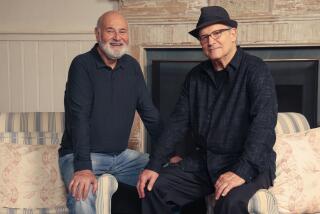Romance and Adventure in the Right Hands : ‘The Princess Bride’: Light as Air and True to Romantic Traditions
Heroic fantasies, we often feel, should be lighter than air, hot as dragon fire, fast as a sword in sunlight. And that’s mostly what we get from the delightful “The Princess Bride” (selected theaters)--along with some bracing humor and foolery.
The original 1973 novel-pastiche by scenarist William Goldman had more pessimism. It suggests that our illusion-blasting world can’t support such perfect romantic fantasy. But director Rob Reiner’s movie has become a purer piece of escapism: a gently sophisticated, tongue-in-cheek barrage of wry swordplay and blithe sorcery--with the painful edges buried deeper down.
In “The Princess Bride,” everything is gloriously magnified and satirically undercut: derring-do tempered with wisecracks. The plot is full of hairbreadth escapes, heart-stoppingly beautiful heroines, heart-crushingly cruel villains, cliff-top duels over raging seas, wizards with bargain miracles, pirate galleons, deadly swamps, sadistic six-fingered counts and a gallant, daring threesome who only need to yell “All for one! And one for all!” to be mistaken for the Three Musketeers.
The plot is consciously prototypical: a princess (Robin Wright) kidnaped back and forth, entrapped by the vile Prince Humperdinck (Chris Sarandon), pursued by her lover Westley (Cary Elwes) and her one-time kidnapers Inigo Montoya (Mandy Patinkin) and Fezzik (Andre the Giant). Goldman’s special tone--a mixture of boyish enthusiasm and dyspeptically grouchy sarcasm, laced with sports-fan banter--holds it together. The whole film, after a romantic opening, is a nearly non-stop series of chases and rescues; the book actually ended in mid-chase.
Goldman dreamed up “The Princess Bride” for his daughters, who supplied the title, and he published it as a jape: as his alleged abridgment of “S. Morgenstern’s Classic Tale of True Love and High Adventure”--which he claims changed his life when his father read it aloud at his sickbed. In the book, Goldman repeatedly interrupts things to complain about “Morgenstern’s” satiric excesses. In the much gentler framing device of the movie--which has a generally warmer sensibility--Peter Falk, as a rough and rumpled grandfather, reads “The Princess Bride” to another sick child (Fred Savage) in a room full of electronic playthings. The story gradually draws them together.
The movie isn’t a visual dazzler like “Legend,” “Ladyhawke” or “Labyrinth.” Rob Reiner specializes in low-key humor and dryly sympathetic character observation, and this is a low-key epic. When he takes us into Humperdinck’s castle or the torture chamber of the insidious Count Rugen (Christopher Guest), he has an almost overly matter-of-fact approach. Even when he shows us a cliff, up which a black-masked pirate is pursuing three hired assassins and the princess, he doesn’t flaunt the thrill.
Reiner’s easy pace and camera style hearken back to “The Crimson Pirate” or the Curtiz-Flynn “Robin Hood.” Reiner and Goldman often tend to sacrifice action or spectacle for humor. The clearest example is their elimination, perhaps for budgetary reasons, of one of the book’s most exciting sequences: Inigo’s and Fezzik’s odyssey through the Zoo of Death, a crawly, murderous trap full of snakes and spiders, Arabian Garstinis and king bats.
The slightly skimped spectacle in the second half of “The Princess Bride” is a flaw, because the wonderful first half raises so many expectations. But, if “The Princess Bride” doesn’t excite the senses the way the Lucas-Spielberg extravaganzas do, it’s because its strategies are gentler, more tied to character. Thanks to Goldman’s script and Reiner’s sure-handed touch, it has more comic depth. A cool wind of mensch-style simpatico streams over these magical forests, the characters are lovable or hissable, and in Mandy Patinkin’s sword-for-hire Inigo, the film has a great, archetypal action hero--frayed Erroll Flynn with dollops of De Niro and Robin Williams.
All the actors get the right subliminally mocking tone. Falk, Wallace Shawn, Guest and Billy Crystal (as the kvetching wizard, Miracle Max) stand out especially, along with the French wrestler Andre the Giant as Fezzik--who at 7 foot 5 and 525 pounds, would stand out anywhere, even in the Lakers’ forecourt.
But it’s Patinkin who scores a special triumph. In his role--a seeming hybrid of Athos, Scaramouche and Yojimbo--there’s a poignant strain of weariness beneath the leaping bravado, a pain under the braggadocio. Patinkin’s final duel with Guest--staunching a seemingly fatal wound, while crying over and over, “Hello! My name is Inigo Montoya! You killed my father! Prepare to die!”--is Goldman’s summation of every grand sword fight in every swashbuckler of his youth. Reiner doesn’t have to give it spectacular staging this time because Patinkin gives it spectacular wit and emotion. Such is heroism, apparently; such is fantasy--and such is the eternal escape hatch of “happy ever after” toward which “The Princess Bride” (MPAA-rated PG) beckons us once again.
‘THE PRINCESS BRIDE’ A 20th Century Fox Film Corp. release of an Act III Communications production. Producers Andrew Scheinman, Rob Reiner. Director Reiner. Executive producer Norman Lear. Music Mark Knopfler. Camera Adrian Biddle. Production design Norman Garwood. Editor Robert Leighton. With Cary Elwes, Mandy Patinkin, Chris Sarandon, Wallace Shawn, Andre the Giant, Robin Wright, Peter Falk, Fred Savage, Peter Cook, Billy Crystal, Carol Kane.
Running time: 1 hour, 41 minutes.
MPAA rating: PG (parental guidance suggested; some material may not be suitable for children).
More to Read
Only good movies
Get the Indie Focus newsletter, Mark Olsen's weekly guide to the world of cinema.
You may occasionally receive promotional content from the Los Angeles Times.








